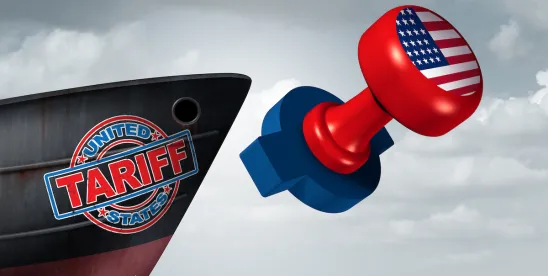Welcome to this month’s issue of The BR International Trade Report, Blank Rome’s monthly digital newsletter highlighting international trade, cross-border investment, and geopolitical risk issues impacting businesses domestically and abroad. We invite you to share this resource with your colleagues and visit Blank Rome’s International Trade webpage for more information about our team.
Recent Developments
Tariffs and trade negotiations:
Trump Administration announces new reciprocal tariff rates for trading partners, effective August 1. In early July, President Trump began releasing copies of letters that his administration sent to U.S. trading partners, outlining updated tariff rates for products imported into the United States. Although additional country-specific tariff rates may yet be announced, beginning August 1, products imported from the following countries will be subject to the tariff rates below:
- Algeria: 30%
- Bangladesh: 35%
- Bosnia and Herzegovina: 30%
- Brazil: 50%
- Brunei: 25%
- Cambodia: 36%
- Canada: 35%
- European Union: 30%
- Indonesia: 32%
- Iraq: 30%
- Japan: 25%
- Kazakhstan: 25%
- Laos: 40%
- Libya: 30%
- Malaysia: 25%
- Mexico: 30%
- Moldova: 25%
- Myanmar: 40%
- Philippines: 20%
- Serbia: 35%
- South Africa: 30%
- South Korea: 25%
- Sri Lanka: 30%
- Thailand: 36%
- Tunisia: 25%
United States announces 35 percent tariffs on Canadian goods. President Trump announced the levies on July 10, with the new rate set to go into effect on August 1. Meanwhile, U.S.-Canada trade negotiations continue, with Canadian Prime Minister Mark Carney recently stating that Canada may need to accept tariffs as part of a U.S. trade deal.
Ongoing Trade Negotiations:
- Vietnam. On July 2, President Trump announced that the United States had negotiated a trade deal with Vietnam which would result in a 20 percent tariff on Vietnamese-origin products. Hanoi has yet to formally accept the deal, as reports indicate that Vietnam agreed to an 11 percent tariff rate—not the 20 percent announced by the United States.
- European Union. EU leaders continue to pursue trade negotiations with the United States but, should the coming weeks fail to produce a deal, Brussels is preparing to impose countermeasures.
- India. New Delhi reportedly is fast-tracking its trade negotiations with Washington in an effort to secure a deal prior to the August 1 deadline. Indian leaders are also prepared to impose countermeasures on the United States, at least with respect to U.S. auto tariffs, informing the World Trade Organization’s (“WTO”) Council for Trade Goods that the country “reserves the right to suspend concessions or other obligations . . . [which] would result in an equivalent amount of duty collected from products originating in the United States.”
- Japan. Trade negotiationsbetween the United States and Japan continue, but Tokyo appears unwilling to strike a deal before the August 1 deadline unless Washington agrees to soften its position on automobile tariffs.
- Indonesia. After months of negotiations, the United States and Indonesia have finalized a trade deal, slashing U.S. tariffs on Indonesian goods from 32 percent to 19 percent, while granting American exports full tariff-free access. The pact includes major purchases of U.S. energy, agriculture, and Boeing jets.
- President Trump announces 10-15 percent tariffs on more than 150 small nations. On July 16, while meeting with Bahrain’s Crown Prince Salman bin Hamad Al Khalifa, President Trump stated his plan to impose 10-15 percent tariffs on more than 150 countries. The announcement will be made in a single letter, similar to previous tariff communications.
- White House previews 50 percent tariff on imports of copper. During an early July Cabinet meeting, President Trump announced that the United States would impose a 50 percent tariff on imports of copper following the U.S. Department of Commerce’s (“Commerce”) Section 232 investigation. Although the official report from Commerce has yet to be released and the president has not yet issued an Executive Order (“EO”), tariffs are expected to take effect on August 1.
- Commerce initiates new Section 232 actions aimed at polysilicon and drones. On July 1, the Commerce Department launched dual Section 232 investigations into polysilicon and its derivatives—often used in the production of solar cells—and drones, according to Federal Register notices published July 16. The new actions follow a flurry of existing Section 232 investigations under the Trump Administration, which assess national security impacts of specified imports and allow Commerce to recommend remedies such as tariffs.
- President Trump threatens tariffs on BRICS countries and their allies. Leaders from the BRICS countries (Brazil, Russia, India, China, South Africa, Indonesia, Ethiopia, and Iran) met in Rio de Janeiro in early July to discuss policy at the 17th BRICS summit. On the first day of the summit, President Donald Trump announced that any country aligning itself with BRICS policies—which tend to oppose U.S. policies on various geopolitical issues—would be subject to an additional 10 percent tariff.
- President Trump directs U.S. Trade Representative to initiate a Section 301 investigation of imports from Brazil. In a July 9 letter to Brazilian President Luiz Inácio Lula da Silva, President Trump criticized Brazil’s treatment of former president Jair Bolsonaro, citing his ongoing trial on charges of attempting a coup, and directed the U.S. Trade Representative to launch a Section 301 investigation that could result in the imposition of tariffs against Brazil.
President Trump terminates most sanctions against Syria. On June 30, President Trump issued EO 14312, “Providing for the Revocation of Syria Sanctions.” The EO terminates most sanctions against Syria, while leaving in place sanctions against remnants of the ousted Assad regime and its supporters, as well as terrorist organizations and other malign actors. The EO also paves the way for easing of export controls under the Export Administration Regulations, although the Trump Administration has not yet implemented this.
U.S. Department of Agriculture (“USDA”) announces farm security action plan. On July 8, U.S. Secretary of Agriculture Brooke Rollins announced the USDA’s National Farm Security Action Plan to address national security threats posed by the control of U.S. farmland by foreign adversaries. Pursuant to the plan, the USDA will work with federal and state authorities to take action to address such threats. Furthermore, Secretary Rollins entered into a memorandum of understanding with U.S. Treasury Secretary Scott Bessent to provide for enhanced cooperation between the USDA and the U.S. Department of the Treasury in its role as chair of the Committee on Foreign Investment in the United States (“CFIUS”).
NATO countries agree to boost defense spending. At this year’s 76th NATO Summit, NATO member states agreed to spend 5 percent of their respective gross domestic product (“GDP”) on defense, up from the previous 2 percent benchmark, to be better equipped to combat rising global tensions. Spain, however, secured an exemption from the 5 percent pledge, and expects to spend 2.1 percent of its GDP on defense.
China imposes export controls on EV battery technology. On July 15, the Chinese Ministry of Commerce announced export licenses will be required for technologies used in EV battery manufacturing and lithium processing. The restrictions have the potential to preserve China’s dominance in the EV battery sphere and will make it harder for foreign nations to build independent supply chains.
For continuous, up-to-date information on the evolving administrative landscape, check out Blank Rome’s Trump Administration Resource Hub. Explore previous BR International Trade Reports here.








 />i
/>i
